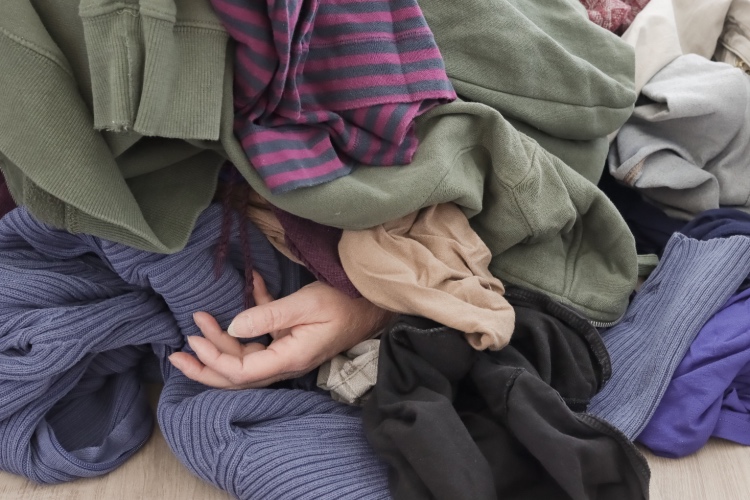
Senior Hoarding
Hoarding is not just about clutter; it’s a complex behavior deeply rooted in emotional and psychological struggles. For our aging loved ones, this behavior can significantly impact their health, safety, and overall quality of life. Recognizing the signs early and understanding the underlying issues is crucial.
Table of Contents:
- Hoarding Behavior
- Early Signs of Hoarding
- Impact of Hoarding on Health and Safety
- How to Approach a Loved One About Hoarding
- Role of Blue Moon Senior Counseling
- Frequently Asked Questions
Hoarding Behavior
Hoarding behavior often results in the accumulation of an excessive number of items, which can fill and clutter living spaces to the extent that their intended use becomes impossible. Individuals who hoard may experience significant distress at the thought of discarding items, leading to a compromised quality of life. Common characteristics of hoarding include:
- Compulsive Acquisition: A strong urge to collect or save items, even those with little or no value.
- Difficulty Discarding: An inability to part with possessions, often due to perceived emotional attachment or fear of needing them in the future.
- Cluttered Living Spaces: Accumulation of items that clutter living areas, obstruct pathways, and make spaces unusable for their intended purposes.
- Impaired Functionality: The hoarded items interfere with daily activities, such as cooking, cleaning, or moving around the house.
Causes and Triggers
The causes of hoarding behavior are multifaceted and can vary from person to person. Several factors may contribute to the development of hoarding:
- Genetics: Studies suggest that hoarding can run in families, indicating a possible genetic predisposition.
- Brain Function: Abnormalities in brain function, particularly in areas related to decision-making and emotional regulation, can play a role in hoarding.
- Traumatic Events: Significant life events, such as the death of a loved one, divorce, or financial loss, can trigger hoarding as a coping mechanism.
- Mental Health Conditions: Hoarding is often associated with mental health disorders like obsessive-compulsive disorder (OCD), anxiety, and depression.
- Environmental Factors: Growing up in a cluttered or chaotic environment may contribute to the development of hoarding behaviors.
Additionally, A study at Johns Hopkins University found that around 4% of the general population collects and stores items excessively. Among people over 55, this number rises to about 6.2%.
Common Misconceptions
Several misconceptions about hoarding can hinder understanding and support for those affected:
- Hoarding Is Just Messiness: Hoarding is not simply about being messy or disorganized; it is a severe psychological condition that requires intervention.
- Hoarders Are Lazy: Hoarding is not a result of laziness. It stems from deep-seated emotional and psychological issues that prevent individuals from discarding items.
- They Can Stop Anytime: Overcoming hoarding behavior often requires professional help, as it involves complex emotional and cognitive challenges.
- Hoarding Is a Choice: Hoarding is not a deliberate lifestyle choice but a mental health disorder that affects an individual’s ability to make rational decisions about their possessions.
Early Signs of Hoarding in Aging Loved Ones
Research shows that these are just some of the signs of hoarding.
Accumulation of Items
One of the earliest signs of hoarding is the noticeable accumulation of items, often in large quantities. These items can range from newspapers and magazines to clothing and household goods.
Difficulty Discarding Possessions
Individuals who hoard often struggle to discard items, even those that are broken, outdated, or have little value. This difficulty stems from a deep emotional attachment or a fear of needing the items in the future.
Social Withdrawal and Isolation
Hoarding can lead to social withdrawal and isolation as individuals may feel embarrassed or ashamed of their living conditions. They may avoid inviting friends or family into their homes.
Impact of Hoarding on Health and Safety
Hoarding can have severe implications on the health and safety of individuals who engage in this behavior, as well as those who live with or care for them. The clutter and chaos that characterize hoarding environments create numerous hazards and challenges that can compromise their well-being.
Physical Health Risks
The physical health risks associated with hoarding are significant and can include:
Respiratory Issues
Accumulation of dust, mold, and mildew in cluttered spaces can lead to respiratory problems such as asthma, allergies, and other chronic respiratory conditions. Poor ventilation exacerbates these issues, creating an unhealthy living environment.
Pest Infestations
Hoarded items can attract pests such as rodents, insects, and other vermin. These pests can spread diseases, contaminate food supplies, and cause structural damage to the home.
Unsanitary Conditions
Hoarding often leads to unsanitary conditions, with items obstructing access to cleaning areas and hygiene facilities. This can result in the buildup of bacteria, viruses, and other pathogens, increasing the risk of infections and illnesses.
Fire Hazards
The risk of fire is a critical concern in homes affected by hoarding. Common fire hazards include:
Flammable Materials
Hoarded items, particularly paper, clothing, and other combustible materials, can serve as fuel for fires. The sheer volume of these items can cause fires to spread rapidly and uncontrollably.
Blocked Exits
Clutter can block windows, doors, and other exits, making it difficult or impossible to escape in the event of a fire. This can lead to severe injuries or fatalities.
Overloaded Electrical Circuits
Hoarders may use multiple electrical devices and extension cords, leading to overloaded circuits and an increased risk of electrical fires.
Risk of Falls and Injuries
Cluttered living spaces significantly increase the risk of falls and injuries, especially for older adults. Common hazards include:
Obstructed Pathways
Items strewn across floors can create tripping hazards, leading to falls that can result in fractures, sprains, and other injuries.
Unstable Stacks
Piles of hoarded items can become unstable and topple over, causing injuries to anyone nearby.
Difficulty Navigating
Navigating through cluttered spaces can be challenging, particularly for individuals with mobility issues or visual impairments. This increases the likelihood of accidents and injuries.
Mental Health Implications
The impact of hoarding on mental health should not be overlooked. Living in a hoarded environment can contribute to:
Increased Stress and Anxiety
The chaotic and cluttered environment can cause significant stress and anxiety for both the hoarder and their family members. The overwhelming nature of the clutter can lead to feelings of helplessness and frustration.
Social Isolation
Hoarders may withdraw from social interactions due to embarrassment or fear of judgment. This isolation can exacerbate feelings of loneliness and depression.
Strained Relationships
The stress and challenges associated with hoarding can strain relationships with family members, friends, and caregivers. Conflicts may arise over the hoarding behavior, leading to tension and resentment.
How to Approach a Loved One About Hoarding
Approaching a loved one about hoarding requires empathy, patience, and effective communication. Here’s a streamlined guide to help you navigate this sensitive issue:
Compassionate Communication
Choose a calm, private moment to talk, avoiding times of stress. Use “I” statements to express your concerns, such as, “I’ve noticed that it’s becoming difficult to move around the house, and I’m worried about your safety,” to avoid sounding accusatory. Emphasize your concern for their well-being rather than focusing on their behavior. Patience is essential; hoarding is deeply ingrained and won’t change overnight.
Avoiding Judgment and Criticism
Avoid judgment and criticism, which can lead to defensiveness. Listen actively and allow them to express their feelings without interruption. Show empathy and validate their emotions. Instead of labeling them as a “hoarder,” discuss specific actions or patterns you’ve observed. Maintain a calm demeanor to help de-escalate tension.
Offering Support and Assistance
Offer to help sort and organize items, respecting their boundaries and pace. Encourage setting small, manageable goals and celebrate progress. Be a consistent source of emotional support, checking in regularly. Building trust and rapport is crucial; be consistent in your words and actions, respecting their privacy and autonomy.
Role of Blue Moon Senior Counseling
Blue Moon Senior Counseling specializes in addressing the unique emotional and psychological needs of seniors, including those struggling with hoarding. Our licensed therapists are committed to promoting the well-being of older adults through compassionate counseling, education, and advocacy. We understand that hoarding is often linked to deep-seated emotional issues such as anxiety, depression, or grief, and we tailor our approach to meet each client’s specific needs. By providing telehealth services, we ensure that seniors can receive the necessary support from the comfort and safety of their own homes
At Blue Moon Senior Counseling, our goal is to help seniors lead healthier, more fulfilling lives by providing the tools and support needed to manage and overcome hoarding behaviors. For more information or to schedule a consultation, contact Blue Moon Senior Counseling through our form here or give us a call at 630-896-7160.
Frequently Asked Questions
- What is the difference between hoarding and collecting?
Hoarding involves the excessive accumulation of items to the point that it interferes with daily living, while collecting is organized and does not impair functionality.
- How can I help a loved one who is hoarding?
Approach them with compassion, avoid judgment, encourage professional help, and offer practical support.
- Are there specific therapies for hoarding disorder?
Yes, cognitive-behavioral therapy (CBT) is commonly used to address hoarding disorder.
- What are the signs that my loved one needs professional help?
Signs include significant accumulation of items, cluttered living spaces, difficulty discarding possessions, and social withdrawal.
- How does Blue Moon Senior Counseling assist with hoarding issues?
We provide tailored counseling services, addressing the underlying psychological issues and offering support and practical solutions.
